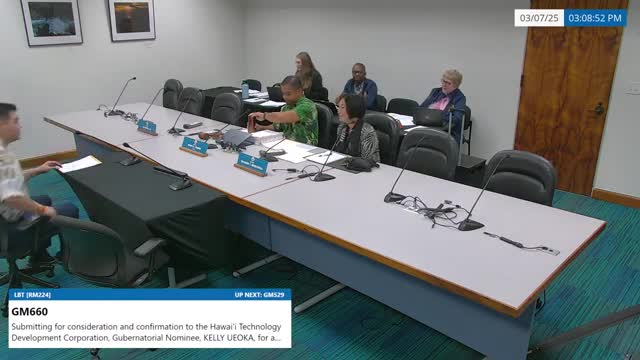Hawaii Workforce Development Council nominees highlight tech visibility and apprenticeship programs
March 08, 2025 | Senate Committee on Labor and Technology, Senate, Legislative , Hawaii
This article was created by AI summarizing key points discussed. AI makes mistakes, so for full details and context, please refer to the video of the full meeting. Please report any errors so we can fix them. Report an error »

In a pivotal meeting held on March 8, 2025, the Senate Committee on Labor and Technology in Hawaii convened to discuss critical issues surrounding workforce development and technology advancement in the state. The atmosphere was charged with a sense of urgency as committee members and nominees shared insights on the challenges and opportunities facing Hawaii's economy.
One of the key discussions centered on the need for increased visibility and support for Hawaii's technology sector. A representative from the Hawaii Technology Development Corporation (HTDC) highlighted the importance of attracting major tech firms like Amazon Web Services and Google to the islands. He emphasized that enhancing visibility could lead to greater investment and job creation, particularly in the fields of information technology and cyber defense. "We need to articulate our message better to draw interest from these large technology providers," he stated, underscoring the potential for growth in Hawaii's tech landscape.
The conversation also touched on the pressing issue of federal funding, with concerns raised about the potential impacts of changing federal policies on local initiatives. The representative expressed hope that Hawaii's advancements in technology could be better communicated to secure necessary funding, especially in light of a recent infrastructure modernization act aimed at phasing out outdated technology systems.
As the meeting progressed, nominees for various workforce development positions shared their visions for the future. Ken Louie, a nominee for the Hawaii Workforce Development Council, spoke about the importance of creating opportunities for both young and adult workers. He acknowledged the challenges posed by staffing shortages but expressed optimism about executing the state’s strategic plan for workforce improvement.
Jared Higashi, another nominee, emphasized the need for a diverse representation within the council, particularly from the tourism sector, which is Hawaii's largest private employer. He outlined initiatives aimed at addressing workforce shortages through mentorship and internship programs, aiming to bridge the gap between education and employment in the tourism industry.
The committee's discussions highlighted a collective commitment to fostering a robust workforce that can adapt to the evolving economic landscape. As the meeting concluded, the sense of collaboration and determination among the participants was palpable, leaving attendees hopeful for a future where Hawaii's workforce is not only resilient but also thriving in the face of technological advancements and economic challenges.
One of the key discussions centered on the need for increased visibility and support for Hawaii's technology sector. A representative from the Hawaii Technology Development Corporation (HTDC) highlighted the importance of attracting major tech firms like Amazon Web Services and Google to the islands. He emphasized that enhancing visibility could lead to greater investment and job creation, particularly in the fields of information technology and cyber defense. "We need to articulate our message better to draw interest from these large technology providers," he stated, underscoring the potential for growth in Hawaii's tech landscape.
The conversation also touched on the pressing issue of federal funding, with concerns raised about the potential impacts of changing federal policies on local initiatives. The representative expressed hope that Hawaii's advancements in technology could be better communicated to secure necessary funding, especially in light of a recent infrastructure modernization act aimed at phasing out outdated technology systems.
As the meeting progressed, nominees for various workforce development positions shared their visions for the future. Ken Louie, a nominee for the Hawaii Workforce Development Council, spoke about the importance of creating opportunities for both young and adult workers. He acknowledged the challenges posed by staffing shortages but expressed optimism about executing the state’s strategic plan for workforce improvement.
Jared Higashi, another nominee, emphasized the need for a diverse representation within the council, particularly from the tourism sector, which is Hawaii's largest private employer. He outlined initiatives aimed at addressing workforce shortages through mentorship and internship programs, aiming to bridge the gap between education and employment in the tourism industry.
The committee's discussions highlighted a collective commitment to fostering a robust workforce that can adapt to the evolving economic landscape. As the meeting concluded, the sense of collaboration and determination among the participants was palpable, leaving attendees hopeful for a future where Hawaii's workforce is not only resilient but also thriving in the face of technological advancements and economic challenges.
View full meeting
This article is based on a recent meeting—watch the full video and explore the complete transcript for deeper insights into the discussion.
View full meeting
